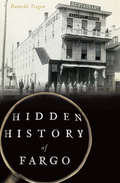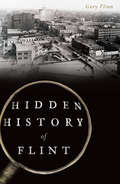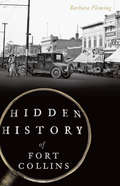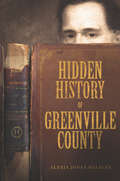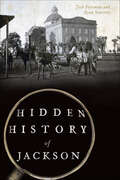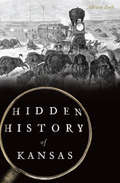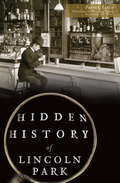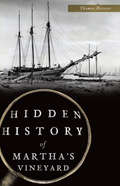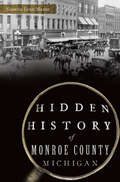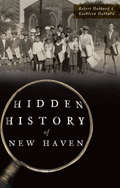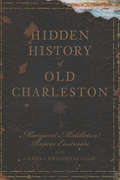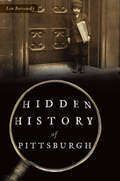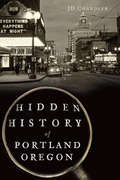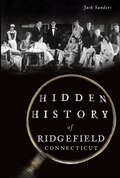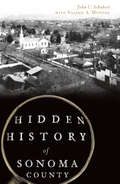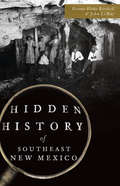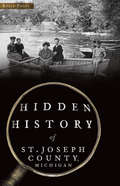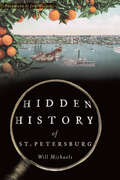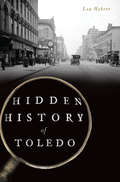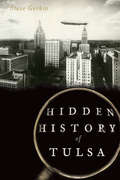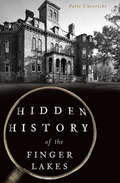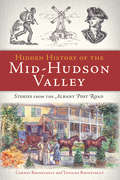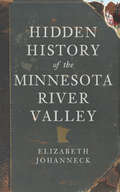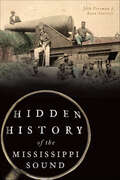- Table View
- List View
Hidden History of Fargo (Hidden History)
by Danielle TeigenFueled by ambition and pipe dreams, Fargo�s earliest residents created an entire city out of the dust of a flat, desolate prairie. Roberts Street might not exist if it weren�t for Matilda Roberts, a resourceful pioneer wife who encouraged her husband�s cousin to set up his law firm on that important downtown thoroughfare. O.J. deLendrecie generated so much success through his retail store that he was able to buy President Theodore Roosevelt�s ranch in western North Dakota. Oliver Dalrymple may have been the bonanza farm king, but the better manager was his rival, Herbert Chaffee of the Amenia and Sharon Land Company. Author Danielle Teigen reveals the intriguing true stories behind many of the most engaging characters and what continues to make the �Gateway to the West� unique.
Hidden History of Flint (Hidden History)
by Gary FlinnBeneath Flint’s auto history lies a buried past. Local Civil War hero Franklin Thompson was actually Sarah Edmonds in disguise. Thread Lake’s Lakeside Amusement Park offered seaplane rides and a giant roller coaster partly built over the water before closing in 1931. Smith-Bridgman’s, the largest department store in town, reigned supreme for more than a century at the same location. And the city’s most prolific inventor, Lloyd Copeman, created the electric stove, flexible ice cube tray and automatic toaster. Gary Flinn showcases the obscure and surprising elements of the Vehicle City’s past, including how the 2014 water crisis was a half century in the making.
Hidden History of Fort Collins (Hidden History)
by Barbara FlemingFrom its Wild West days to the early twentieth century, Fort Collins boasted its share of colorful characters. British import Edith Boothroyd saved a mare from meeting a tragic fate after the bridge she and the horse were traveling across unexpectedly collapsed. In 1915, barnstormer Billy Parker built his first biplane in a local field. Happy Jack slipped away from prison after slyly convincing the jailer to loosen his restraints. And Francis Carter-Cotton left investors holding the bag when he fled to Canada after racking up $300,000 in debt. Barbara Fleming divulges these entertaining stories and more.
Hidden History of Fort Myers
by Cynthia A. Williams Denége PattersonAlthough best known as the winter home of Thomas Edison and Henry Ford, Fort Myers has one of the most engaging and extraordinary histories of any city in Florida. The spawn of a hurricane, Fort Myers began as a U.S. Army post during Florida�s Seminole Wars. During the Civil War, it became a battleground between Confederates and Yankees for cattle and, after the war, a gun-slinging cowboy town. New York cartoonist Walt McDougall blew into the area on a fishing trip, and his glowing description lured down other wealthy Yankee sportsmen who helped turn this isolated frontier town into a modern tourist destination. Historian and author Cynthia Williams explores the hidden stories behind the growth of this beautiful city.
Hidden History of Greenville County (Hidden History)
by Alexia Jones HelsleyHistorically, Greenville County owes much to its natural advantages of scenery, location and abundant water, but it has also benefited from its colorful characters, such as Richard Pearis, Vardry McBee, Richard Furman and the Earle family. Hidden History of Greenville County details the personalities, places and events that have given Greenville its progressive, diverse environment. Join archivist and history professor Alexia Helsley as she explores some of these individuals and their contributions, as well as little-known events in the area and the ever-fascinating "Dark Corner." From mansions to murders, learn things about Greenville County history that you've never encountered before.
Hidden History of Jackson (Hidden History)
by Josh Foreman Ryan StarrettThe history of Jackson is filled with gripping tales of horrors and heroism. Join Ryan Starrett and Josh Foreman as they reveal the hidden past of the City with Soul.A recording company founded in the mid-1960s with the expectation of competing with New Orleans and Memphis was a national success, outlasting its better-funded rivals. Known as the "Devil's Backbone," the Natchez Trace is the graveyard for countless travelers slain by the road's numerous serial killers, brigands and land pirates. Yet one mass grave stands above the others: the Boyd Mounds, which hold the remains of thirty-one Choctaws. Although legend has it that the father of Jackson, Louis LeFleur, was a Canadian trapper famous in high society for his dancing, the truth is even stranger.
Hidden History of Kansas (Hidden History)
by Adrian ZinkKansas’ storied past is filled with fascinating firsts, humorous coincidences and intriguing characters. A man who had survived a murderous proslavery massacre in 1858 hanged his would-be executioner five years later. A wealthy Frenchman utilized his utopian ideals to create an award-winning silk-producing commune in Franklin County. A young boy’s amputated arm led to the rise of Sprint Corporation. The first victim of the doomed Donner Party met her end in Kansas. In 1947, a housewife in Johnson County, indignant at the poor condition of the local school for black children, sparked school desegregation nationwide. Author and historian Adrian Zink digs deep into the Sunflower State’s history to reveal these hidden and overlooked stories.
Hidden History of Lincoln Park (Hidden History)
by Patrick ButlerBefore Lincoln Park cemented its trendy reputation, plenty of odd and unruly history managed to settle into its foundation. A Viking ship, mob henchmen and ladies of the evening all took up residence in the same part of town where Dwight L. Moody went from selling soles to saving souls. Thanks to a Confederate ferryboat crewman, many of Lincoln's personal effects belong to the neighborhood named after him. Patrick Butler uncovers Lincoln Park's forgotten contributions to Chicago's heritage, from the "Pleasure Wheel" on Navy Pier to the city's cycling craze.
Hidden History of Martha's Vineyard (Hidden History)
by Thomas DresserBehind the mansions and presidential vacations of Martha’s Vineyard hide the lost stories and forgotten events of small-town America. What was the island’s role in the Underground Railroad? Why do chickens festoon Nancy Luce’s grave? And how did the people of the Vineyard react in 1923 when the rumrunning ship John Dwight sank with the island’s supply of liquor aboard? Delve deep below the surface of history to discover the origin and meaning of local place names and the significance of beloved landmarks. Celebrated local historian Thomas Dresser unearths the little-known stories that laid the foundations for the community of Martha’s Vineyard.
Hidden History of Monroe County, Michigan (Hidden History)
by Shawna Lynn MazurOften overshadowed by its larger neighbors, Monroe County offers a rich tapestry of history for those willing to look.French-Canadian settlers left behind legends of monsters, ghosts, and witches. In war time, the community answered the call to arms with more soldiers per capita than any other county in the nation and proved a suitable hometown to take refuge between gun shots from none other than George Armstrong Custer. Like most communities, its sordid past reveals crimes and tragedies--including body snatching. More recently, a partial nuclear meltdown brought the city to the brink of disaster, but Monroe not only survived but now thrives.Join local author Shawna Lynn Mazur for a trip through little-known and forgotten parts of Monroe County's past.
Hidden History of New Haven (Hidden History)
by Kathleen Hubbard Robert HubbardThe celebrated history of New Haven often overshadows its fascinating and forgotten past. The Elm City was home to America's first woman dentist, an architect who designed the tallest twin towers in the world and a medical student who used toy parts to create an artificial heart pump. A city noted as the home of one of the top universities in the world, New Haven is also home to the third-oldest independent school in the United States, the first African American to receive a PhD degree and the founding of what would become the largest Catholic fraternal benefit society in the world. The city's share of disasters includes Connecticut's worst aviation crash, a zookeeper who was mauled to death and a fire at the Rialto Theater. Local authors Robert and Kathleen Hubbard reveal the rich and fascinating cultural legacies of one of New England's most treasured cities.
Hidden History of Old Charleston (Hidden History)
by Margaret Middleton Eastman Edward FitzSimons GoodFrom the Lowcountry's first recorded duel to old-fashioned summers at the "hottest spot in town", these pages will captivate you with stories of people, events and places that have all but vanished from memory. Find out the real history behind some of Charleston's beloved mansions and learn about the early plantations and their owners. Join the authors as they relate the riots and romance, the preservation and politics - and even a ghost story - from Charleston's hidden history.
Hidden History of Pittsburgh (Hidden History)
by Len BarcouskyWhen Mark Twain visited in 1884, he claimed to spy a little bit of hell in Pittsburgh's smoky appearance. Twain's observations are among the many riveting firsthand accounts and anecdotes to be found in the archives of the Pittsburgh Post-Gazette. The Great War hit home after the sinking of the Lusitania, which carried more than a dozen Pittsburgh residents. A few years later, cheering throngs of black and white residents lined downtown streets to welcome African American soldiers returning home from the conflict. The Ringling Brothers Circus held its last outdoor performance here in 1956 and left eight hundred show workers without jobs in the city. With these stories from the archives and more, veteran journalist Len Barcousky shines a light on the hidden corners of Pittsburgh's history.
Hidden History of Portland, Oregon (Hidden History)
by Jd ChandlerIn this engaging narrative, author JD Chandler crafts a people's history of Portland, Oregon, sharing the lesser-known stories of individuals who stood against the tide and fought for liberty and representation: C.E.S. Wood, who documented the conflict between Native Americans and the United States Army; Beatrice Morrow Cannady, founding member of the Portland NAACP and first African American woman to practice law in Oregon; women's rights advocate Dr. Marie Equi, who performed abortions and was an open lesbian; and student athlete Jack Yoshihara, who, in the wake of Pearl Harbor, was barred from participating in the 1942 Rose Bowl. From scandal and oppression to injustice and the brink of revolution, join Chandler as he gives voice to the Rose City's quiet radicals and outspoken activists.
Hidden History of Ridgefield, Connecticut (Hidden History)
by Jack SandersTime nearly erased many astounding tales and unexpected anecdotes from Ridgefield's history. Its colorful characters include a widow who built a landmark Manhattan hotel, her neighbor who invented one of the first "helicopters" and a CIA operative who helped one thousand Americans flee Saigon at the end of the Vietnam War. Lesser known are the stories of the Ridgefield artists who gave the world Superman and Lowly Worm and brought the Wild West to life. One local writer helped make Hawthorne famous, while another penned thousands of hymns still sung around the globe. Join retired newspaper editor Jack Sanders as he uncovers nearly forgotten people and moments of Ridgefield's past.
Hidden History of Sonoma County (Hidden History)
by Valerie A. Munthe John C. SchubertThe enterprising spirit that led to Sonoma County's storied agricultural heritage defined its earliest denizens. Sail the seas with Captain Bodega y Quadra, whose name graces the coast and beyond, and wave farewell to the last train out of the redwoods. Discover the fate of Charles Henley, spirited from the county jail in 1876 by masked vigilantes. Learn about the rise and fall of Sonoma's tobacco growers and the historic opening of the Jenner Bridge as the automobile rose in popularity. John Schubert and Valerie Munthe reveal Sonoma County's enthralling history.
Hidden History of Southeast New Mexico (Hidden History)
by Donna Blake LemayOutlaws, cattlemen and a plethora of quirky pioneers once riddled southeastern New Mexico. In November 1892, E.W. Doll and J.B. Coates ignited rumors of an eight-foot petrified man in McKittrick Cave. A massive fire and subsequent shootout led to the demise of Phenix, one of the Old West’s most scandalous towns. And in August 1932, Bonnie and Clyde kidnapped Carlsbad’s Deputy Sheriff Joe Johns. Authors Donna Blake Birchell and John LeMay explore these little-known tales and more that have beguiled this region for centuries.
Hidden History of St. Joseph County, Michigan (Hidden History)
by Kelly PucciMichigan established St. Joseph County in 1829. It was a fertile land with an abundance of fresh water supplied by the St. Joseph River. The county’s colorful past is the result of forgotten locals and visitors. Hezekiah Thomas fished for diamonds in Corey Lake. Saloon smasher Carrie Nation sold miniature hatchets at the county fairgrounds. The United States Congress recognizes the village of Colon as the Magic Capital of the World, and Lakeside Cemetery is the final resting place of more magicians than any other cemetery on the globe. Author and historian Kelly Pucci digs into the entertaining and often overlooked history of St. Joseph County.
Hidden History of St. Petersburg (Hidden History)
by Will Michaels Jon WilsonFlorida is one of the most visited places in the world, and one of its most visited cities is St. Petersburg. But there's a lot more to the "Sunshine City" than pristine beaches. During his travels to sunny St. Pete, James Brown discovered local jazz artist LeRoy Flemmings Jr. Doc Webb's World's Most Unusual Drug Store attracted customers and spectators from afar. Babe Ruth's longest home run ever was launched from the city. William Straub had a great vision for the area's treasured waterfront park system, and the historic Vinoy Hotel was instrumental in launching the downtown renaissance. City historian Will Michaels explores a wide swath of hidden history in one of Florida's largest cities.
Hidden History of Toledo (Hidden History)
by Lou HebertToledo's history as a frontier town turned manufacturing powerhouse is well known. However, few know that it was once home to a champion racehorse that galloped into the record books. Many are unaware that East Toledo's verdant urban woodlands sprang from the work of just one man or that a local girl's meteoric rise in Golden Age Hollywood saw her play alongside Groucho Marx. Fewer still have heard of Officer Dell Hair, crime fighter and rhyme maker who walked the beat and walked into the history books as a celebrated cop-poet. These tales and more await as award-winning local broadcaster Lou Hebert shines a light into the forgotten corners of Glass City history.
Hidden History of Tulsa (Hidden History)
by Steve GerkinThe story of Tulsa's transformation from a nineteenth-century cow town into the "Oil Capital of the World" has been above ground for years, but a great reservoir of Tulsey Town's heritage has remained beneath the surface. These neglected tales include the dirigible flyover of 1929, the Hominy Indians' victory over the New York Giants and the legendary final performance of Spade Cooley, convicted killer and the self-proclaimed "King of Western Swing." From the horrors of the city's early race riot and the proud legacy of Greenwood (aka Little Africa or Black Wall Street) to Tulsa's iconic landmarks and unforgettable personalities, Steve Gerkin provides an evocative and enjoyable voyage through T-Town's hidden history.
Hidden History of the Finger Lakes (Hidden History)
by Patti UnverichtNew York's Finger Lakes region is filled with compelling characters, tragic disasters and fascinating mysteries.Famed daredevil Sam Patch, known as the "Yankee Leaper," thrilled audiences at Niagara Falls but took his last jump into the Genesee River with his pet black bear, plummeting to his death. The first ever Memorial Day was celebrated in Waterloo in 1866 and inspired a nation to adopt the holiday. Seneca Lake claims its fair share of ships, including the Onondaga, which was blown up with dynamite as part of a spectacle to commemorate the sinking of the USS Maine. Author Patti Unvericht reveals the forgotten history of the Finger Lakes region.
Hidden History of the Mid-Hudson Valley: Stories from the Albany Post Road (Hidden History)
by Tatiana Rhinevault Carney RhinevaultThe Albany Post Road was the vital artery between New York City and the state capital in Albany in the eighteenth and nineteenth centuries. It saw a host of interesting events and colorful characters, though these unusual and extraordinary stories, as well as their connection to the thoroughfare, are oft forgotten. Revolutionary War spies marched this path, and anti-rent wars rocked Columbia County. Underground Railroad safe houses in nearby towns like Rhinebeck and Fishkill sheltered slaves seeking freedom in Canada, and Frank Teal's Dutchess County murder remains unsolved. With illustrations by Tatiana Rhinevault, local historian Carney Rhinevault presents these and other hidden stories from the Albany Post Road in New York's mid-Hudson Valley.
Hidden History of the Minnesota River Valley (Hidden History)
by Elizabeth JohanneckTraveled by mammoth-hunters and motorcyclists alike, the Minnesota River Valley shows the traces of a unique legacy: where else are you going to find a political party with ideals based on honest conversation and gymnastics? Not all of it is as lovely as the natural scenery it accompanies�Mankato was the site of the largest mass execution in United States history�but its heritage demands contemplation. Discover the valley�s most enterprising characters, from Fort Snelling bootleggers like Pierre �Pig�s Eye� Parrant to the Granite Falls lawyer behind Prohibition, Andrew Volstead. With a guide like Johanneck, you might meet some familiar figures in surprising circumstances as she steals up behind Dr. Mayo at the grave he was robbing for medical research or catches FBI director J. Edgar Hoover in a moment of unguarded correspondence.
Hidden History of the Mississippi Sound (Hidden History)
by Josh Foreman Ryan StarrettInside are thirteen little-known tales from the Gulf Coast from Lake Borgne to Mobile.Sail into the Mississippi Sound with Bienville, the Frenchman covered in serpentine tattoos. Meet the heroes of the Sound: fearless Father LeDuc, who faced down Yankee pillagers; the wild woman of Horn Island, who could shoot as well as any man; and Ray Nosaka, who fed his body to the dogs of war, all in service of his country. Glimpse a school of the Sound's own patron fish, the striped mullet, Biloxi's bacon. But don't get too comfortable on the beach - a hurricane is always on the horizon. Join authors Josh Foreman and Ryan Starrett on this journey into the hidden history of the Mississippi Sound.
